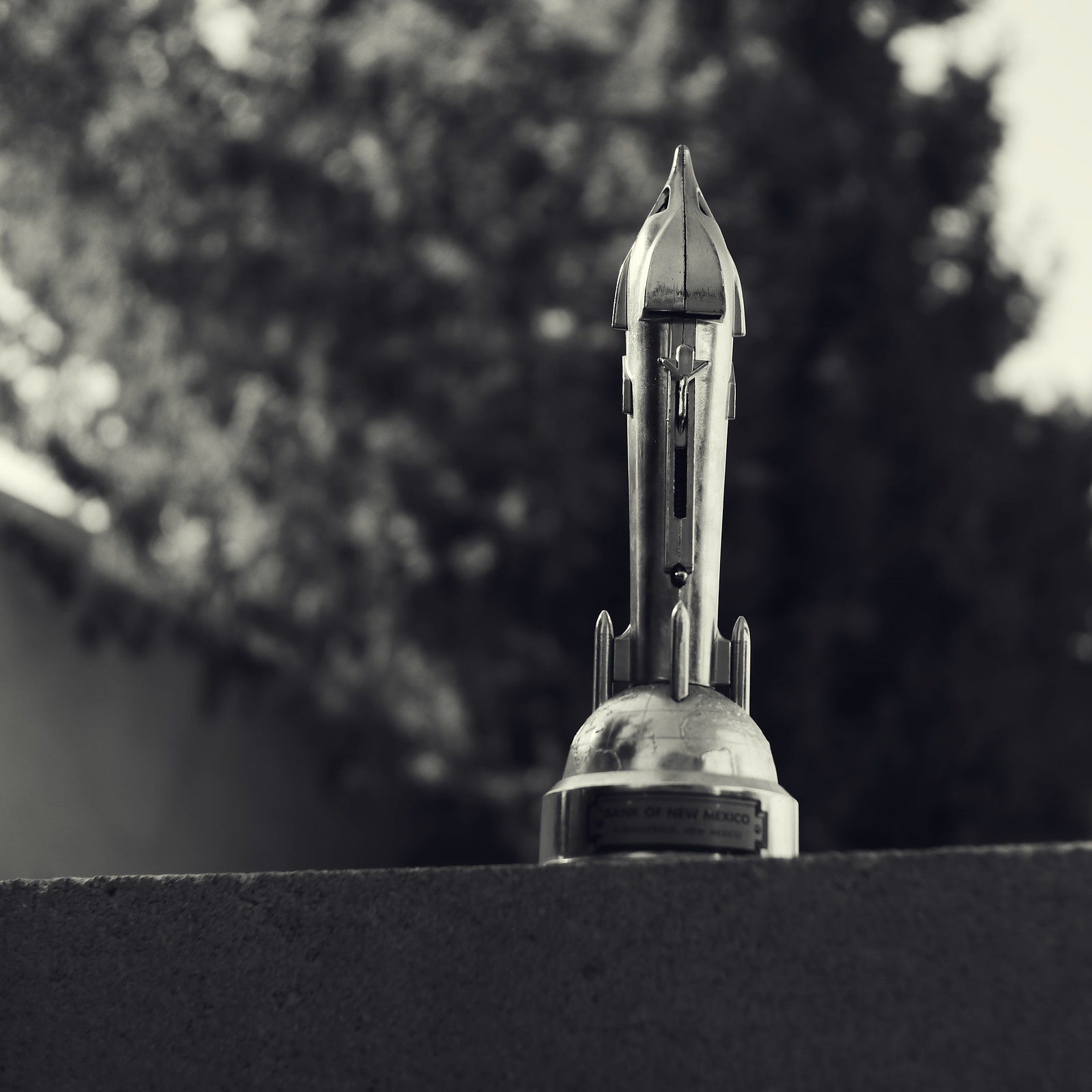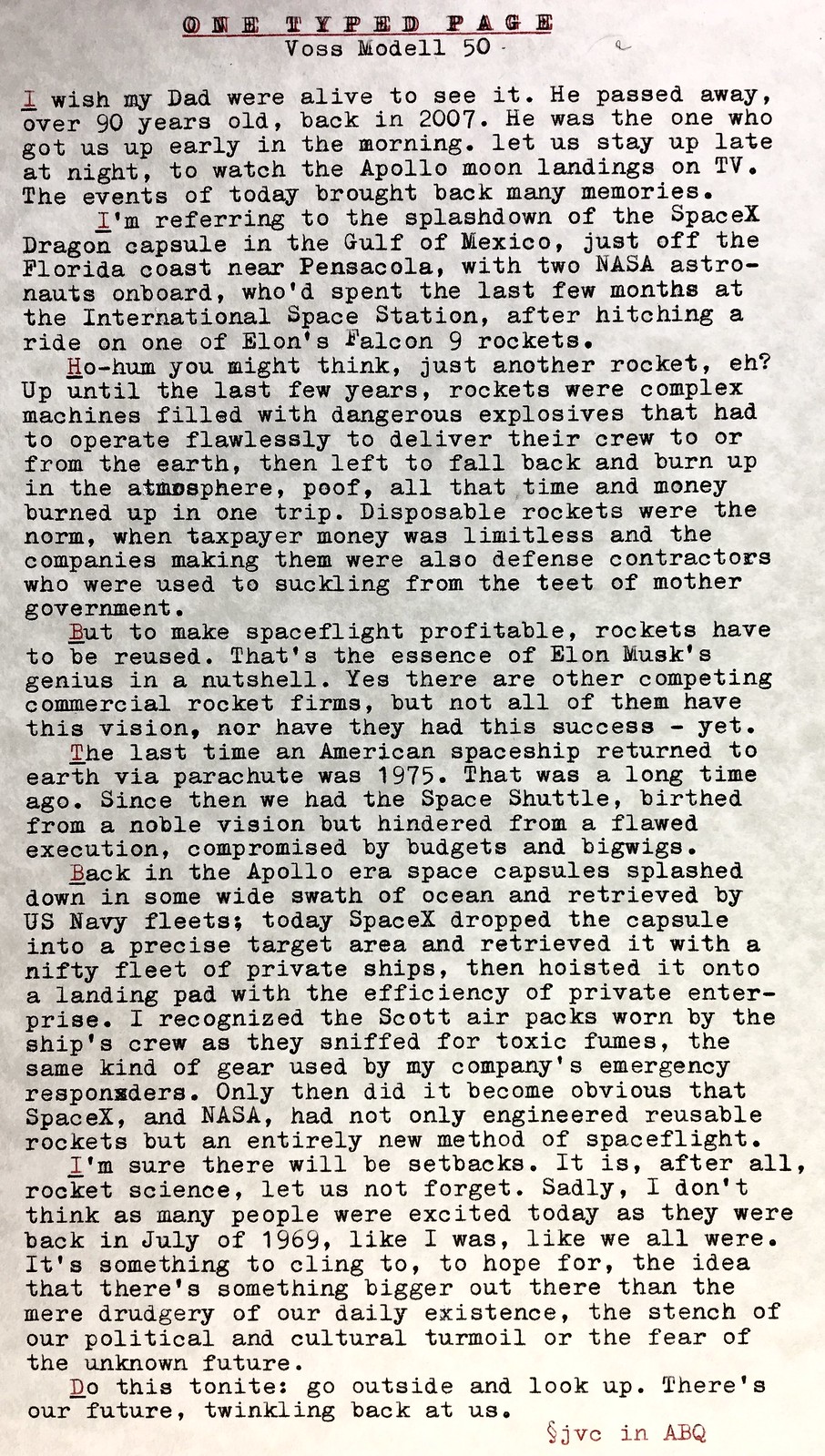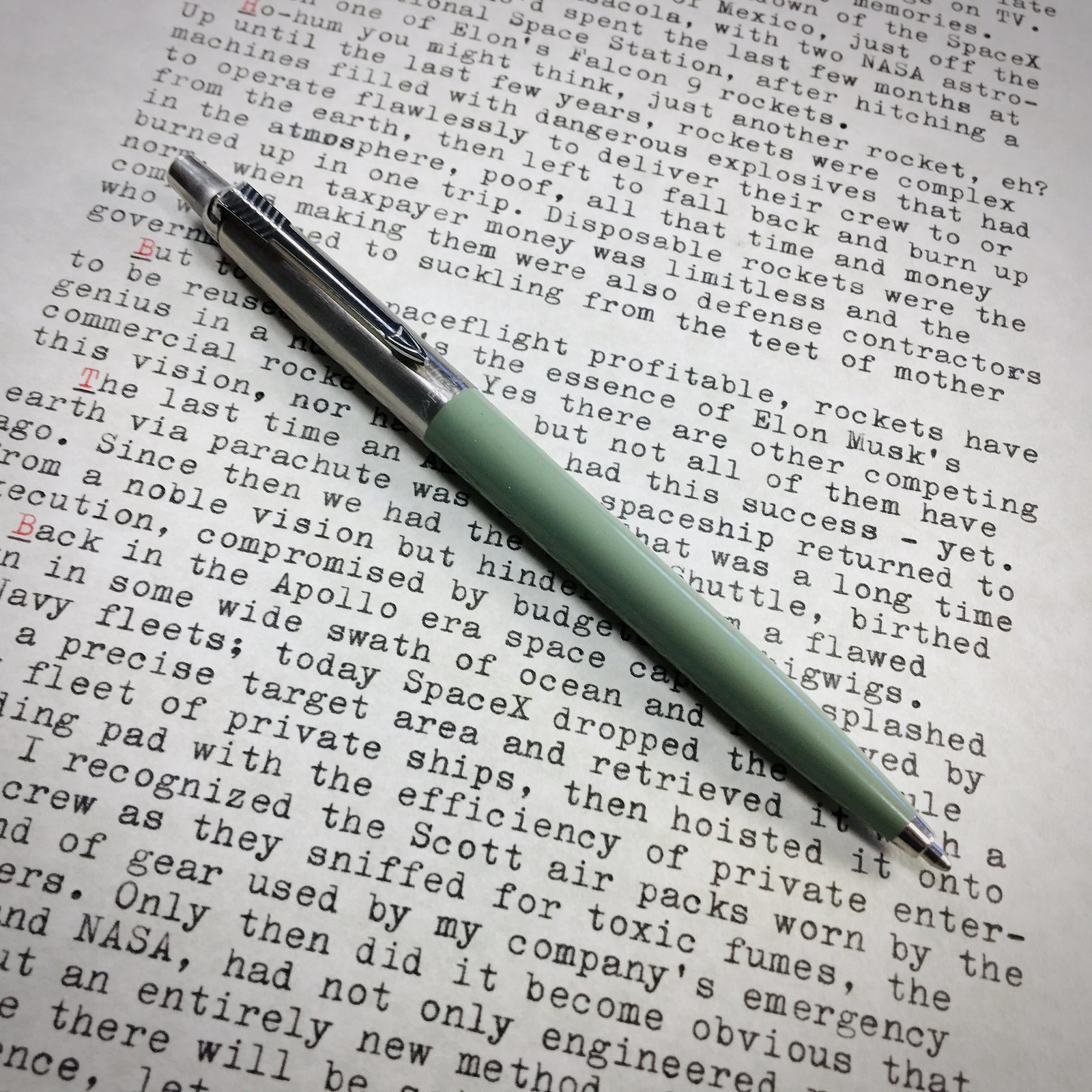Looking Up


It was sometime in the very early 1960s when Dad brought home these rocket banks. He worked out on Sandia Base, at a place called D.A.S.A. - Defense Atomic Support Agency, Field Command, Cataloging Department; later renamed D.N.A - Defense Nuclear Agency. He set up the system that catalogs the parts for the nation's "special weapons." Years later, sometime in the 1990s or early aughts, I met some of the ladies who still worked in his same department, they said the system he set up was still being used.
In the geography of the Cold War, Sandia was a place where the "physics packages," designed by Los Alamos and Livermore, were turned into practical, field-ready weapons, safe enough to be handled by soldiers and sailors with high school diplomas and rugged enough to withstand the abuse of deployment.
Dad was a meticulous documenter. He balanced his checkbook to the penny, using his clearly legible printing, which featured little details like horizontal serifs on the loops of the capital "J". I can imagine this worked well for the kind of career he had with that secretive government agency.

Dad always used these Parker ballpoint pens, with the brushed metal rear half and pastel colored plastic front. There was often one in his shirt pocket, or clipped to that checkbook that was always balanced to the penny. This one's mine, but I think he had one in this very same color. I don't use it that often - part of the problem of being a pen collector - but keep this one mainly because of Dad.
Bank of New Mexico had a branch office on the Base, which was where Dad got these rockets banks from. There's a vertical slot on the side of the bank, and a part above it that looks somewhat like the middle of a peace sign, inverted; or a crucifix with broken arms. There's a lot to unpack in these symbols; I'll leave that up to you.
A coin could be nestled into those broken crucifix arms, then the bank cocked by pulling the fixture down along the slot. When the button below the slot was pressed, it would shoot the coin up into the nosecone of the rocket - clank! - and the coin would rattle down into the bottom, preserved for that future college education. We loved watching the coins being shot into the bank much more than the idea of saving for our education. Go figure.
The base of the bank can be unlocked using a simple key, which we'd long ago lost, but a bent paper clip works well. I think my two brothers each still have their rocket banks. These weren't just fun toys for us to play with, but they also served as tokens representing the fact that we were very interested in the space program of the 1960s. I was born in '57, coming of age around the time of Apollo, and remember well our space infatuation.
My middle brother and I would play astronaut at Grandma's house. We'd set up the card table against the sofa. The card table was taller than the cushions of the sofa, so we'd lie on our backs under the table with our legs up on the sofa cushions, in that reclining position common to astronauts. We'd enhance the effect by covering the table with a large blanket, enclosed as if in our tin capsule, then play with pretend control dials we'd taped to the underside of the table. We do a countdown, then one of us (usually me, because I was the younger) would stand outside the pretend capsule and rock the table back and forth while spewing rocket-like sounds and droplets of sputum, the latter unintentional but common to overly-energetic young lads.
Later, we realized our pretend capsule wasn't realistic enough, so my middle brother and I commenced to build our own capsule in our grandparent's back yard, using aged lumber from a pile out by the shed near the alley.

My grandparents former house at 112 Edith St. NE in Albuquerque, now a law office.
The pile of lumber, I only learned more recently, came from circa 1929, when Grandpa had leased the ranch land to some businessmen who made an Indianapolis-style dirt racetrack, with wooden bleachers and a tall wooden fence that surrounded the 160-acre property, located near where the corner of Central and Wyoming are now. When the Depression hit hard, the racetrack went bankrupt and left Grandpa with an abandoned property. He built a shack of wood to live in, and dismantled the wooden structures and sold them off to make spare cash. With the remnants of that lumber we - my middle brother and I - made a go-cart and space capsule, in the late 1960s. From Google Earth you can still see remnants of the south turn of the oval racetrack, now located on Base property, between the Officer's Club and the north fence line adjacent to the Wyoming Gate entrance. After WWII the government had annexed part of Grandpa's ranch land to expand Sandia Base.
The capsule we built resembled a Gemini-style conical shape, built on a circle of boards as a base, with the sides of the conical capsule made of boards leaned up together, teepee-style. More bits and bobs were used to decorate the inside of the capsule to our liking. We'd have launches during every weekend visit to our grandparents, where my brother would lie on his back in the capsule and I'd shake it while roaring and spewing forth my boyhood energy, imagining him soaring into the sky on a column of flame and smoke. Later on we'd try making our own rocket engines from wooden kitchen match heads, but they only were good for smoke bombs.
One summer evening before dark there were flashlights flickering up the alley behind the backyard, then police officers entered the yard and questioned the adults assembled therein, a family reunion of sorts. Had they seen the escaped convict they were searching for? Nobody saw the escaped convict, but the officers made sure to search inside Grandpa's shed, and the conical Gemini-style space capsule, just to be certain no one was hiding. Years later I'd imagine that escaped convict, hiding in the spaceship, ready to blast off from earth to some better place.
These are the kinds of memories that come flooding back when I watch notable space events, like this week's return of the SpaceX Crew Dragon capsule from orbit. My oldest grandson doesn't seem much interested, not many kids his age seem to be. I suppose it's an artifact of my generation's era, whatever happens during one's formative years seems to make a lasting impression. If there's to be a permanent and expanding space program it's going to require a permanent fanbase of supporters who petition their congressional representative to allocate the funds. As it was, Apollo was cut short by the economic ravages of Vietnam and the Cold War. Maybe our choices are endless wars, or space exploration, but not both? Maybe. In the meantime, keep looking up.
Labels: Albuquerque, memories, star-gazing

3 Comments:
That's a beautiful rocket bank.
When I was a kid I was thrilled by the Apollo missions. Now I have to admit I'm in the camp of people who barely pay attention to space, although I do appreciate images from Hubble and the Mars explorers. Marveling at the universe is a fine and deep thing, yet it seems so much more urgent to care for our home planet. Besides, the main purpose of most missions, starting with the Space Shuttle, has not been wonder, it seems to me, but commerce and control.
The launch on 27 Many as well as yesterday's splashdown brought back many memories of my fascination with outer space as a boy. I remember going out to a mountain top look out whit my grandpa hoping we'd see Sputnik. Never did, but when an amateur radio fellow left me listen one night I got hooked on radio. I still remember watching Alan Sheppard's lift off when I was at my Uncle's house. John Glenn and the whole works. I sadly remember the losses, Apollo 1, as well as Columbia and Challenger. The best one was Christmas eve of 1968. My comment will get way too long to write about that. I got to watch several shuttle launches and others when I lived in FL With a sense of loss I also got to watch the last shuttle launch.
When I saw the first photo, of the rocket bank, I immediately thought it was the point of a glass dipping pen. You can see where my mind is.
By the way, the Parker pen was called "the Jotter." The model with the metal ring around the tip was far better than the all plastic barrel, which had a tendency to break, especially if dropped on a hard surface.
Parker also made a matching instrument called the "Liquid Lead Pencil," to form a set. The liquid lead was in a filler very much like an ink cartridge. It appeared to have powdered graphite in an oil suspension, and was erasable like ordinary lead.
Phil
Post a Comment
<< Home